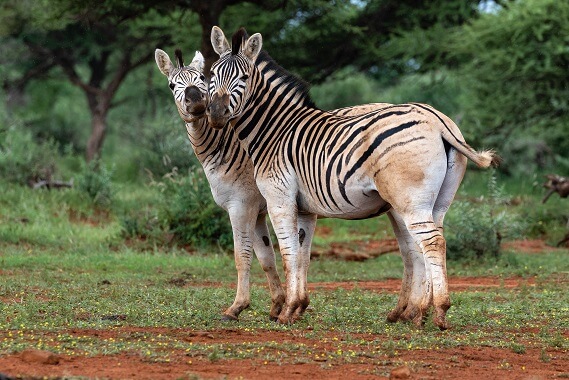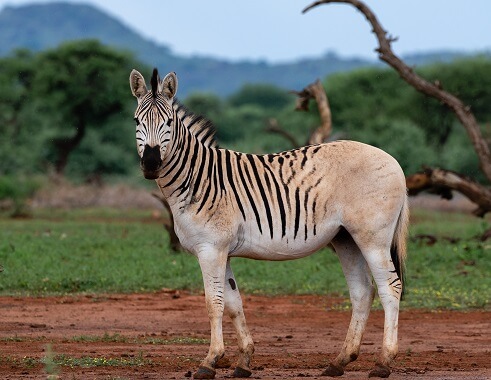
The quagga (Equis quagga quagga) was a plains zebra found in South Africa that went extinct in the late 19th century. More closely related to the zebra, than a horse, the quagga looked like a mixture of the two. The rear of its body was brown with no patterning, whereas the front had brown and white stripes, like the stripes of a zebra. This pattern of stripes varied between each individual. The quagga was, for a long time, thought to be a distinct species but DNA analysis showed that it was actually a subspecies of the plains zebra. This zebra lived in herds that roamed the Karoo desert and other dry regions of southern Africa. The herds were formed from family members that remained with the herd throughout their entire life. If members of the herd became lost, the dominant male of the group emitted a special call that other members of the group would respond to. These social animals also cared for their sick or crippled herd members and would slow down the pace of the herd to ensure the slowest animal could keep up. Quaggas were diurnal and would spend the night time in short pastures where they could keep watch for approaching predators. At least one quagga would remain on watch while the rest of the herd slept. This zebra species was polygynous, meaning that it had a harem-base mating system where a single male mated with a group of females. The gestation period was 12 months. Foals could be born at any time of year, but December-January was the peak time for quaggas to give birth. A female would reach sexual maturity at 3 – 3.5 years old and would give birth to one foal roughly every two years. After the Dutch settled in South Africa, the quagga was hunted extensively for its meat, hide, and because it competed with domestic animals for the vegetation that it fed on. Another problem was that few people realized that this species was distinct from the other zebras and so little was done to conserve it. Quaggas disappeared from the wild in the 1870s and the last captive animal died at Amsterdam zoo in the 1880s. Interestingly, laws protecting the quagga from hunting were passed in South Africa in 1883, three years after the death of the last known animal. It looked more like a horse than a zebra, but the quagga was a subspecies of the plains zebra and was closely related to the zebras that we still see today in nature documentaries, zoos, and on the plains of Africa. Although it was hunted to extinction by humans, the quagga provides information on some amazing biological concepts and interesting facts! Let’s take a closer look. For a long time, people had many misconceptions about the quagga. For example, many people believed that the quagga was a species in its own right as it had a unique appearance. Whereas scientists believed that the quagga was more closely related to wild horses than zebras and it wasn’t until after it went extinct that scientists were able to find out the truth. In 1984, scientists took samples from existing quagga skins and analyzed the DNA. What they found was that the quagga was not closely related to the wild horse at all, but that it was a subspecies of the plains zebra. The plains zebra is the zebra that everyone knows – it is found across Africa and in zoos around the world. The DNA evidence suggests that the quagga evolved its unique coat pattern fairly recently in terms of evolution. Scientists believe that they become isolated from other plains zebras and rapidly evolved the brown coloration and less striped pattern, likely during the Pleistocene. When a species of animal or plant goes extinct there is no way back! The good news for the quagga is that it was not a species in its own right, but a subspecies of the plains zebra, of which there are several forms. The quaggas full name is Equis quagga quagga. Once scientists realized that the quagga was a subspecies, an idea was born that this animal could possibly be bought back through selective breeding, as its traits would still be present in other subspecies. From this fact, the Quagga Project was born! This exciting breeding program has been attempting to reverse the extinction of the quagga since 1987. Over the course of the project, four to five generations have been bred and they are getting increasingly similar to the quagga in looks. Just like when dogs are bred for certain characteristics, the Quagga Project selects zebras that have quagga-like characteristics and breeds them. All animals produced are carefully documented and have their bloodlines tracked. Several quagga-like zebras can now be found in Karoo and Mokala national parks and some private reserves in South Africa. With each generation, some zebras appear to look more and more like the quaggas. The new quaggas are known as “Rau quaggas,” after Reinhold Rau, one of the instigators of the project. The project is not without its critics! Some people think that the scientists may not have taken into account some of the various ecological adaptations that the quagga may have had. The quagga, like all zebras, had long, slender legs that enabled it to run fast to escape from predators. Zebras are so fast that they can run an amazing 40 miles per hour! If its speed wasn’t enough to save it from being attacked, then its extremely strong legs could also be used to kick the predators if they got too close! A zebra is capable of giving such a hard kick with its hooves that it can injure or even kill a creature as large as a lion!
Kingdom
Animalia
Phylum
Chordata
Class
Mammalia
Order
Perissodactyla
Family
Equidae
Genus
Equus
Species
E. quagga
Length
8 ft 5 inches (257 cm)
Height
4 ft 1 in – 4 ft 5 in (125 – 135 cm) at shoulder
Weight
550 – 660 lbs (approximately 250 – 300 kg)
Lifespan
20 – 40 years
Social Structure
Social, family members often stayed together in herds
Status
Extinct since the 1880s
Natural Habitat
Grasslands of Southern Africa
Average Litter Size
1 foal
Main food item
Vegetation such as grass.
Potential predators
Lions, other large mammals, humans
The Basics

Fun Facts about the Quagga!
Sub Species

Quagga Project

Long, slender legs
